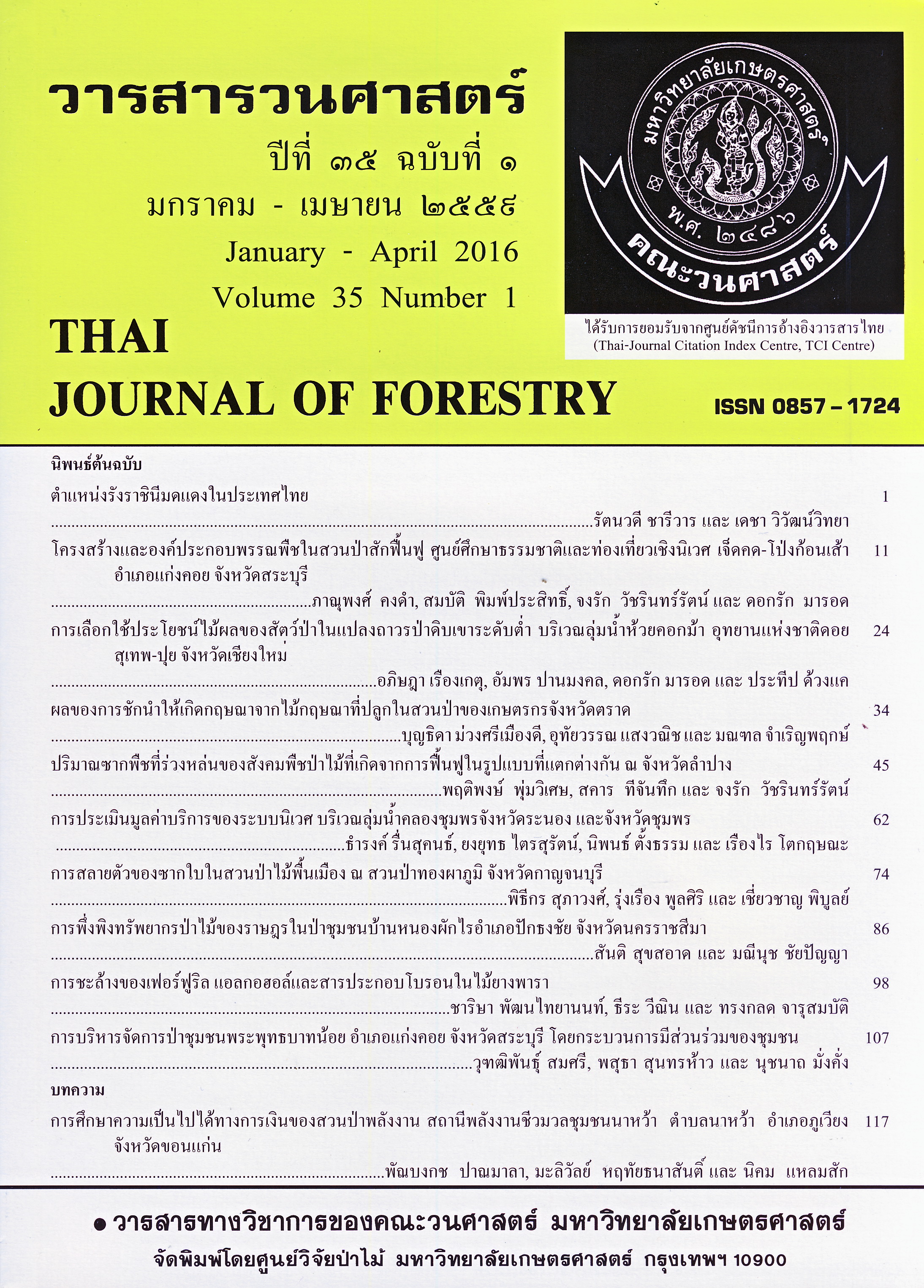การสลายตัวของซากใบในสวนป่าไม้พื้นเมือง ณ สวนป่าทองผาภูมิ จังหวัดกาญจนบุรี
Main Article Content
บทคัดย่อ
Leaf litter decomposition of indigenous tree plantations was carried out at Thong Pha Phum plantation, Kanchanaburi province. Four tree species were used in the experiment, i.e., Tectona grandis Linn. f., Xylia xylocarpa Taub var. kerrii Nielson, Hopea odorata Roxb. and Dipterocarpus alatus Roxb. ex G. Don. The objectives were to study the rates and nutrient releases of four indigenous tree species leaf litter decomposition. The study was conducted between March
2006 and February 2007. Leaf decomposition was evaluated through the litterbag technique and placed on the forest floor. At the end of each month, 3 litterbags of each tree species were collected for dry weight loss and release nutrient determination. The results showed that mean rates of leaf litter decomposition of T. grandis,X. xylocarpa, H. odorata and D. alatus were 73.79, 43.73, 67.96, 57.68% yr-1, respectively. The annual decay constant (k) of the four tree species were 1.3392, 0.5750, 1.1382 and 0.8599, respectively. The concentration of nitrogen (N), phosphorus (P) and calcium (Ca) of T. grandis, X. xylocarpa, H. odorata and D. alatus showed trend decreasing in the beginning and showed increasing trend later. Meanwhile, potassium (K) and magnesium (Mg) were dramatically decreasing in the beginning and were slightly decreasing later. The initial nutrient content of T.grandis was N > Ca > K > Mg > P and X. xylocarpa, H. odorata and D. alatus of those were N > Ca > Mg > K > P. At the end of study found that total nutrient turnover of T. grandis was N > K > Ca > Mg > P, meanwhile X. xylocarpa and H. odorata were N > Ca > Mg > K > P and D.
alatus was N > K > Mg > Ca > P.
Downloads
Article Details
ข้าพเจ้าและผู้เขียนร่วม (ถ้ามี) ขอรับรองว่า ต้นฉบับที่เสนอมานี้ยังไม่เคยได้รับการตีพิมพ์และไม่ได้อยู่ในระหว่างกระบวนการพิจารณาตีพิมพ์ลงในวารสารหรือสิ่งตีพิมพ์อื่นใด ข้าพเจ้าและผู้เขียนร่วม (ถ้ามี) ยอมรับหลักเกณฑ์และเงื่อนไขการพิจารณาต้นฉบับ ทั้งยินยอมให้กองบรรณาธิการมีสิทธิ์พิจารณาและตรวจแก้ต้นฉบับได้ตามที่เห็นสมควร พร้อมนี้ขอมอบลิขสิทธิ์ผลงานที่ได้รับการตีพิมพ์ให้แก่วารสารวนศาสตร์ คณะวนศาสตร์ มหาวิทยาลัยเกษตรศาสตร์ กรณีมีการฟ้องร้องเรื่องการละเมิดลิขสิทธิ์เกี่ยวกับภาพ กราฟ ข้อความส่วนใดส่วนหนึ่ง หรือ ข้อคิดเห็นที่ปรากฏในผลงาน ให้เป็นความรับผิดชอบของข้าพเจ้าและผู้เขียนร่วม (ถ้ามี) แต่เพียงฝ่ายเดียว และหากข้าพเจ้าและผู้เขียนร่วม (ถ้ามี) ประสงค์ถอนบทความในระหว่างกระบวนการพิจารณาของทางวารสาร ข้าพเจ้าและผู้เขียนร่วม (ถ้ามี) ยินดีรับผิดชอบค่าใช้จ่ายทั้งหมดที่เกิดขึ้นในกระบวนการพิจารณาบทความนั้น”
เอกสารอ้างอิง
Attanandana, T. and J. Chancharoensook. 1999. Soil and Plant Analysis. Department of Soil Science, Faculty of Agriculture, Kasetsart University, Bangkok. (in Thai)
Attiwill, P.M. 1968. The loss of elements from decomposing litter. Ecol. 49: 142-145.
Barros, E., B. Pashanasi, R. Constantino and P. Lavelle. 2002. Effect of land-use system on the soil macrofauna in western Brazilian Amazonia. Biol. Fertil. Soils. 35: 338-347.
Berg, B. and C. McClaugherty. 1989. Nitrogen and phosphorus release fromdecomposing litter in relation to the disappearance of lignin. Can. J. Bot.67: 1148-1156.
Bidwell, R.G.S. 1974. Plant Physiology. MacMillan Publishing Co., New York.
Bocock, K.S. 1963. Changes in the amount of nitrogen in decomposing leaf litter of sessile oak (Querqus pertraea). J.Ecol. 51: 555-566.
Bray, J.R. and E. Gorham. 1964. Litter production in forests of the world. Adv. Ecol. Res. 2: 101-157.
Dutta, R.K. and M. Agrawal. 2001. Litterfall, litter decomposition and nutrient release in five exotic plant species planted on coal mine spoils. Pedobiologia 45(4): 298-312.
Liao, J.H., H.H. Wang, C.C. Tsai and Z.Y. Hseu. 2006. Litter production,decomposition and nutrient return of uplifted coral reef tropical forest.For. Ecol. Manage. 235: 174-185.
Lousier, J.D. and D. Parkinson. 1978. Chemical element dynamics in decomposing leaf litter. Can. J. Bot. 56: 2795-2812.
Olson, J.S. 1963. Energy storage and the balance of producers and decomposers in ecological systems. Ecol. 44 (2): 322-331.
Polyakova, O. and N. Billor. 2007. Impact of deciduous tree species on litterfall quality, decomposition rates and nutrient circulation in pine stands. For. Ecol. Manage. 253: 11–18.
Sang-on, P. and R. Poolsiri. 2010. Leaf litter decomposition in exotic tree plantations at the Royal Agricultural Station Angkhang, Chiang Mai province. Thai J. For. 29 (3): 26-35. (in Thai)
Silver, S., G. Dunning, M. Ashton and H. Binko. 2000. Tropical Forest Plantations and Biodiversity. Yale Forest Forum Series Publication. Yale University,Connecticut.
Singh, K.P. 1968. Litter production and nutrient turnover in deciduous forests of Varanasi, pp. 655-665. In R. Misra and B. Gopal, eds. Proceedings of Symposium on Recent Advances in Tropical Ecology. International Society of Tropical Biology, Varanasi, India.
Staaf, H. and B. Berg. 1982. Accumulation and release of plant nutrients in decomposing Scots pine needle litter. Long-term decomposition in a Scots pine forest II. Can. J. Bot. 60: 1561-1568.
Stark, W. 1972. Nutrient cycling pathways and litter fungi. Bioscience 22: 355-360.
Swift, M.J., O.W. Heal and J.M. Anderson.1979. Decomposition in Terrestrial Ecosystems. Blackwell Scientific Publications, Oxford.
Torreta, N.K. and H. Takeda. 1999. Carbon and nitrogen dynamics of decomposing leaf litter in a tropical hill evergreen forest. Eur. J. Soil Biol. 35: 57-63.
Wood, T.G. 1974. Field investigations on the decomposition of leaves of Eucalyptus delegatensis in relation to environment factors. Pedobiologia 14: 343-371.


